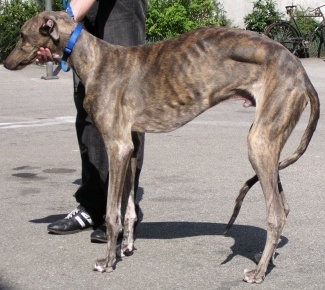
HÄLSOFAKTA
2007 Another Story Waiting For The Sun, "Grace" testad u.a för levershunt
2/10 2009 Another Story Waiting For The Sun, "Grace"
testad fri från Greyhound Neuropathy
Se resultat
Greyhound Hereditary Neuropathy
by Dr Barbara Kessler

Within the last years, a few kennels throughout Europe reported on the
sporadic birth of puppies, who suddenly developed abnormal gait and
progressive muscle atrophy from an age of around 3 months on. First,
breeders and owners assumed that they had to deal with singular cases,
but soon it turned out to be a common new problem, a new Greyhound
disease, not yet described in scientific literature.
Clinical Symptoms
Usually, first signs of the disease occur at an age of 3-4 months, in
some cases not before 8-9 months. Affected puppies quite suddenly show
an abnormal gait with arched back and rear weakness, which may suppose
an injury in loin. Within a few days or weeks, condition gets worse,
the puppies visibly loose muscle and hardly can walk or run for more
than 200-300 metres. Even just a few steps lead to fatigue, puppies are
no more able to fully stretch the knee joints. They show a strange,
"bunny-like" hopping gallop with turned-out knees, later on they
collapse and cannot walk anymore. After a few minutes of recreation,
they recover strength and can continue walking for another short
distance.
In addition to the abnormal gait, neurologic deficits come to the fore
of the pathogenesis. The spinal reflexes are highly decelerated resp.
totally absent, especially the patellar tendon reflex. In contrast,
sensoric and proprioreceptive functions are usually not affected.
With increasing age, muscle weakness is more and more progressive, the
gait gets wobbling and unstable, up to the dogs cannot get up and walk
without help any more. It differs from case to case which muscle groups
are particularly affected. Usually shoulder and thigh, as well as
temporal, back and in some animals also the laryngeal muscles are
highly atrophic. The latter are standing out because they cannot bark
and are sometimes dyspnoeic. Affected puppies don't show any sign of
pain or disturbed well-being, they are alert and full of joie de vivre
until the end. However, they only reach an age of 9 to 13 months until
they have to be put to sleep because of their progressive muscle
atrophy.
Autopsy Findings and Pathogenesis
Usually, autopsy doesn't show any notable macroscopic findings except
of a severe general muscle atrophy. In all Neuropathy puppies who
underwent autopsy a mild hydrocephalus internus could be found, but
this doesn't explain the clinical symptoms in total. Only with special
stainings of nerve sections the underlying defects can be detected.
Affected puppies show a nearly complete degeneration of peripheral
nerve axons, thus leading to an omitted neuronal stimulation of the
muscle, resulting in muscle atrophy.
The supposed cause for the axon degeneration is a disturbed interaction
of axon and myelin sheath, caused by a gene defect. The disease is
inherited in a monogenic autosomal-recessive trait. So called
"carriers" (who have one healthy and one mutated allele) are
phenotypically healthy, powerful dogs - but if two of these carriers
are mated and a puppy inherits a mutated allele from both, it will be
affected by the disease.
Neuropathy Project
Thanks to the help from a lot of responsible breeders and owners, we
could collect a large amount of samples from affected puppies and their
parents, grandparents, littermates, half-siblings and other relatives.
Based on this material, the causative gene defect could be
characterized and a gene test could be developed.
PD Dr. Cord Drögemüller at the Institute of Genetics of the University
of Bern/CH is heading several research projects about genetic diseases
in dogs. He kindly agreed to include the disease Greyhound Hereditary
Neuropathy in his research. More information about the Neuropathy
Project, together with an order form for the gene test is available on
the institute's webpage .
By using the gene test a reliable identification of carriers is
possible now! As long as carriers are never bred to another carrier,
the birth of affected puppies will be excluded in the future. The big
bugbear of Neuropathy, which caused so much uncertainty among show
greyhound breeders, hanging like the sword of Damocles over so many
planned matings, became predictable. So many breeding plans haven't
been realized in the past, because the risk of Neuropathy was estimated
as being too high - nowadays it's possible to avoid the birth of
affected puppies in advance. We urgently recommend to use the gene test
which is available to all greyhound breeders and fanciers!
------------
Gene test for neuropathy in Greyhounds (75.-- EUR)
________________________________________________
____________
Published with permission by the author Dr Barbara Kessler